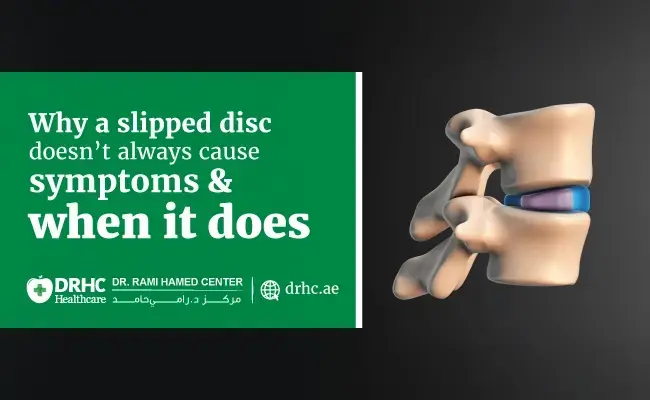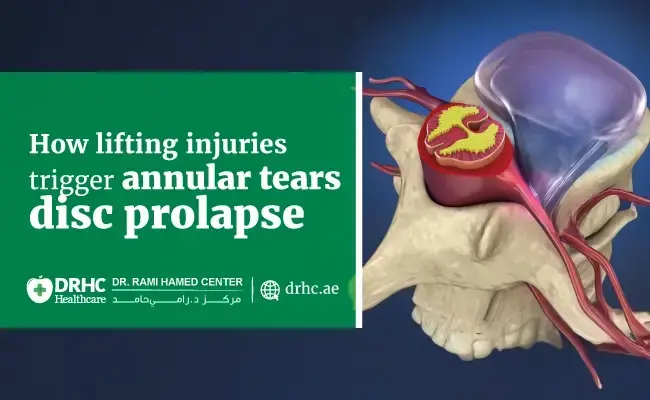
Cervical stenosis is a condition where the spinal canal in your neck becomes too narrow, putting pressure on the spinal cord and nerves. For some people, this narrowing develops slowly over time and causes only mild discomfort. For others, it can progress to cause serious nerve problems that interfere with daily life.
At Dr. Rami Hamed Center (DRHC) in Dubai, many patients come to us worried about whether their cervical stenosis means they will “definitely need surgery.” The truth is — not every case requires an operation. In many situations, non-surgical treatments can help manage symptoms and keep you active. However, there are times when surgery becomes the safest and most effective option.
Understanding Cervical Stenosis
Your cervical spine is made up of seven vertebrae in the neck. The spinal canal runs through these bones, carrying and protecting the spinal cord. In cervical stenosis, this canal becomes narrower, often due to:
- Age-related changes (degenerative disc disease, arthritis)
- Herniated discs
- Bone spurs
- Thickened ligaments
- Previous neck injuries
When Symptoms Are Mild – Non-Surgical Care Comes First
If your stenosis causes only neck pain, stiffness, or occasional tingling in the arms without significant nerve damage, conservative treatments are usually recommended first. These may include:
- Physiotherapy to strengthen neck and shoulder muscles
- Pain-relieving medications or anti-inflammatory treatments
- Posture correction and ergonomic adjustments
- Activity modification to reduce strain on the neck
With regular monitoring, many people can manage their stenosis without surgery.
Signs That Surgery May Be Needed
Surgery is generally considered when the narrowing is severe enough to threaten long-term nerve function or spinal cord health. This may include:
- Progressive weakness in arms or hands
- Loss of coordination in hands or difficulty with fine motor tasks
- Problems with walking or balance
- Persistent or worsening nerve pain despite non-surgical treatments
- Signs of spinal cord compression (myelopathy) on MRI
- Loss of bladder or bowel control — this is rare but an emergency
If these symptoms are left untreated, the nerve damage can become permanent. Surgery aims to relieve the pressure before that happens.
What Cervical Stenosis Surgery Involves
The goal of surgery is to create more space in the spinal canal and relieve pressure on the spinal cord or nerves. Depending on your condition, this may involve:
- Removing bone spurs or part of a disc
- Replacing a damaged disc with an artificial one
- Fusing vertebrae to stabilise the neck
At DRHC Dubai, we use advanced surgical techniques designed to minimise tissue disruption, reduce recovery time, and improve safety. We understand that surgery can feel overwhelming, so we walk patients through every step — from preoperative preparation to personalised rehabilitation.
Recovery After Surgery
Recovery depends on your overall health, the type of surgery, and how severe your symptoms were beforehand. Many patients notice improved arm and leg function within weeks, though full recovery may take several months. A tailored physiotherapy program is often essential for regaining strength and mobility.
Explore Our Related Blogs
- How poor ergonomics can trigger cervical disc herniation
- How long-standing disc bulges lead to foraminal narrowing
- How lifting injuries trigger annular tears and disc prolapse
- Why a slipped disc doesn’t always cause symptoms — and when it does
FAQs – Surgery for Cervical Stenosis
1. Will surgery cure cervical stenosis completely?
Surgery relieves nerve pressure but cannot reverse all age-related changes in the spine. However, it can stop further damage and greatly improve quality of life.
2. How risky is the procedure?
All surgery carries risks, but modern techniques have greatly improved safety. Your surgeon will review specific risks based on your case.
3. Can cervical stenosis get worse if I delay surgery?
If symptoms are progressing or nerve function is deteriorating, delaying surgery can lead to permanent damage.
4. Is there an alternative to surgery?
If symptoms are mild, non-surgical treatments often help. Surgery is usually reserved for more advanced cases.
The Takeaway
Cervical stenosis doesn’t always require surgery — but when symptoms indicate serious nerve compression, timely intervention can protect your long-term mobility and independence.
If you’re in Dubai and experiencing symptoms of cervical stenosis, the spine specialists at Dr. Rami Hamed Center can provide a thorough evaluation and guide you through the safest, most effective treatment options.
Dr. Rami Hamed
Consultant Spine & Orthopedic Surgeon
Founder, DRHC – Dubai Healthcare City
📞 +971 4 279 8800
🌐 www.drhc.ae
📍 Dubai Healthcare City, Building 52
Topic: orthopedic Spine Surgery




.jpg)



Leave a comment